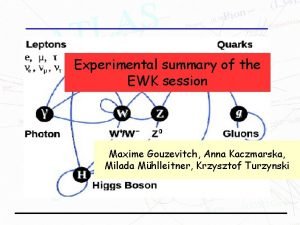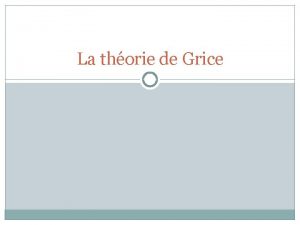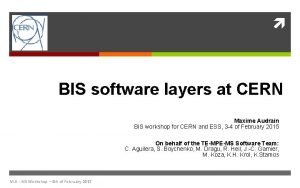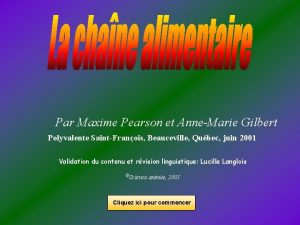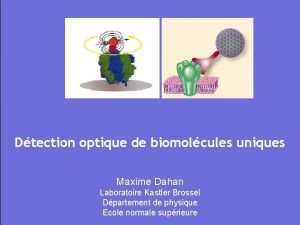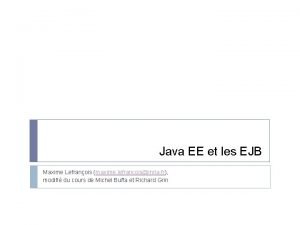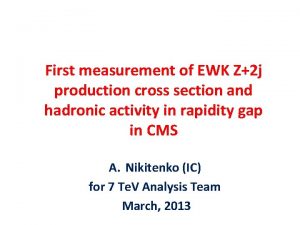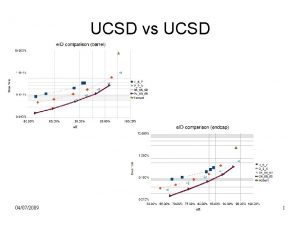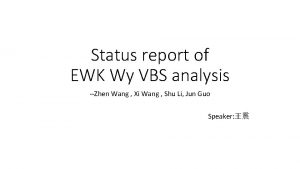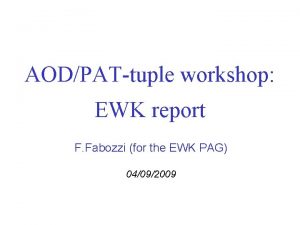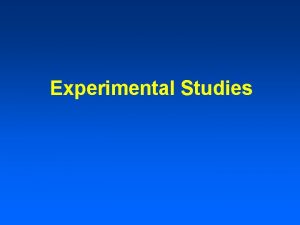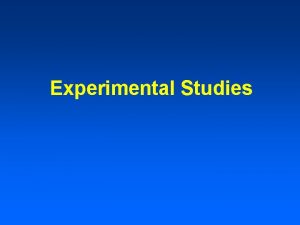Experimental summary of the EWK session Maxime Gouzevitch















- Slides: 15

Experimental summary of the EWK session Maxime Gouzevitch, Anna Kaczmarska, Milada Mühlleitner, Krzysztof Turzynski

EWK session Tuesday 29. 04 morning 8 contributions (3 theory + 5 experimental): T. Kasprzyk, E. -S. Protopapadaki, B. Zhou, M. Gouzevitch, M. Rauch, R. Bellan, M. Luszczak, J. Fischer Measurements covered in this session: VV production at LHC: SM production a. TGC H VV searches/measurements and interplay with SM backgrounds EWK production of Z boson VVV and EWK scattering: First look into EWK scattering: WWWW First look on VVV production: WVgamma a. QGC Interplay between EWSB mechanism and VV VV unitarisation We show the most recent and tantalising results and invite you to look into the talks for more details

Stairway to Hell

Evidence of VV EWK scattering Higgs mechanism unitarise the deviations in VLVL scattering. No enough statistics in Run I to measure it. But we can extract an evidence of the EWK scattering.

Experimentally complex BF of Z boson ar. Xiv: 1403. 5657 Z boson massive neutral particle like Higgs. Similar final states. Support Higgs discoveries. First Observation of Z 4 l decay. First Observation of Z bb in hadron colliders. ar. Xiv: 1403. 3047

Higgs session Wednesday 30. 04 afternoon 8 contributions (4 theory + 7 experimental): V. Sanz, N. Venturi, L. Finco, T. Baroncelli, J. M. Vizan Garcia, P. Jiang, J. Baglio, A. Massorini, T. Du Pree, D. Sidorov, R. Santos Measurements covered in this session: Higgs properties: General fits CMS/ATLAS Higgs coupling to fermions: CMS/ATLAS Search for Exotic Higgs models: CMS/ATLAS We show the most recent and tantalising results and invite you to look into the talks for more details

tt. H Higgs production mechanisms starts to be well constraint. tt. H is the direct way to measure top-Higgs coupling It is still the most challenging due to its small cross section

Higgs width measurement Higgs has a (small) width: only 4 Me. V impossible to measure given the small statistics Higgs couples to mass: right tail of the BW is enhanced when ZZ channel opens. CMS-HIG-14 -002

Resonant HH production CMS-HIG-13 -032 ATLAS-CONF-2014 -005

Exotica searches session Thursday 01. 05 morning (1) 8 contributions (3 theory + 5 experimental): S. Gupta, A. Saha, M. Mozer, G. Busoni, Ki-Young Choi, A. C. Gonzalez, O. Igonkina, T. Peiffer Searches covered in this session: • heavy resonances • di-leptons and lepton+MET • di-bosons • extra dimensions, new strong Sector (technicolor, Little Higgs etc. ) • excited quarks • leptoquarks • mono-X • mono-jets, mono-photons, mono-W/Z • Dark Matter, Large Extra Dimensions, SUSY, Higgs to invisible particles • vector-like quarks, ttbar resonances and W' to tb • topcolor Z', Kaluza Klein excitations, heavy Higgs, Little Higgs models, technicolor, extra dimensions • multiple leptons • excited leptons, LRSM, WR, heavy neutrinos, heavy fermion triplet Again we pick out only a few results today, and refer you to the talks in the session for more details

Dark matter constraints from Hadron colliders Mono-X (jet, photon, V) is reinterpreted for the DM search. Under EFT approximation those results can be compared with direct WIMP searches. Approximation valid only if It can be valid for many events but not for all. Busoni

VV searches Bump searche in VV final state. Model coupling preferentially to vector bosons Not excluded by precise loop measurements Substructure techinque used above Te. V

SUSY searches session Wednesday 30. 04 morning 10 contributions (3 theory + 7 experimental): S. Henrot-Versille, R. Nagai, H. Bakhshiansohi, T. Gillam, N. Saoulidou, E. Popenda, A. Kalogeropoulos, S. Guy Muanza, S. Vallecorsa, B. Dumont Searches covered in this session: • Strong production (1 st+2 nd generation squarks and gluinos) • dominated by inclusive searches • many SUSY models e. g. MSUGRA/ CMSSM dominated by strong production • Strong production 3 rd generation squarks • smaller cross sections • motivation from natural SUSY • EW production • if colored SUSY particles are too heavy, electroweak production can be dominant SUSY production mechanism at the LHC • Long-lived particles and R-parity violating scenarios • experimentally challenging Many interesting results shown, usually several analyses in one talk. It is difficult to give a comprehensive summary in short time. . . We pick out only a few today, and refer you to the talks in the session for more results.

SUSY searches A variety of inclusive SUSY searches successfully deployed No indication of super-partners Naturalness and simplified SUSY models under constraint Searches now goes into: RPV, EWKinos, sleptons, stop, low splitting.

Generic searches Inclusive SUSY searches: General Search • Purely discovery analysis • Select most discrepant part of each channel • 697 exclusive channels! • Work out a p-value for any discrepancy • Account for very large look-elsewhere effect by performing pseudoexperiments
 Maxime gouzevitch
Maxime gouzevitch Experimental vs non experimental
Experimental vs non experimental Quasi experimental design example
Quasi experimental design example Disadvantages of experimental research
Disadvantages of experimental research Experimental vs nonexperimental research
Experimental vs nonexperimental research Experimental vs non experimental
Experimental vs non experimental Les maximes de grice exemples
Les maximes de grice exemples Maxime bergeret
Maxime bergeret Maxime audrain
Maxime audrain Tommy frechette
Tommy frechette Zoopancton
Zoopancton Maxime latinismo
Maxime latinismo Maxime dahan
Maxime dahan Hát kết hợp bộ gõ cơ thể
Hát kết hợp bộ gõ cơ thể Ng-html
Ng-html Bổ thể
Bổ thể
